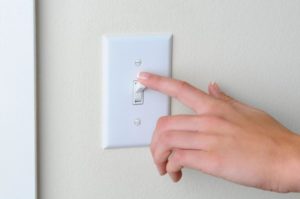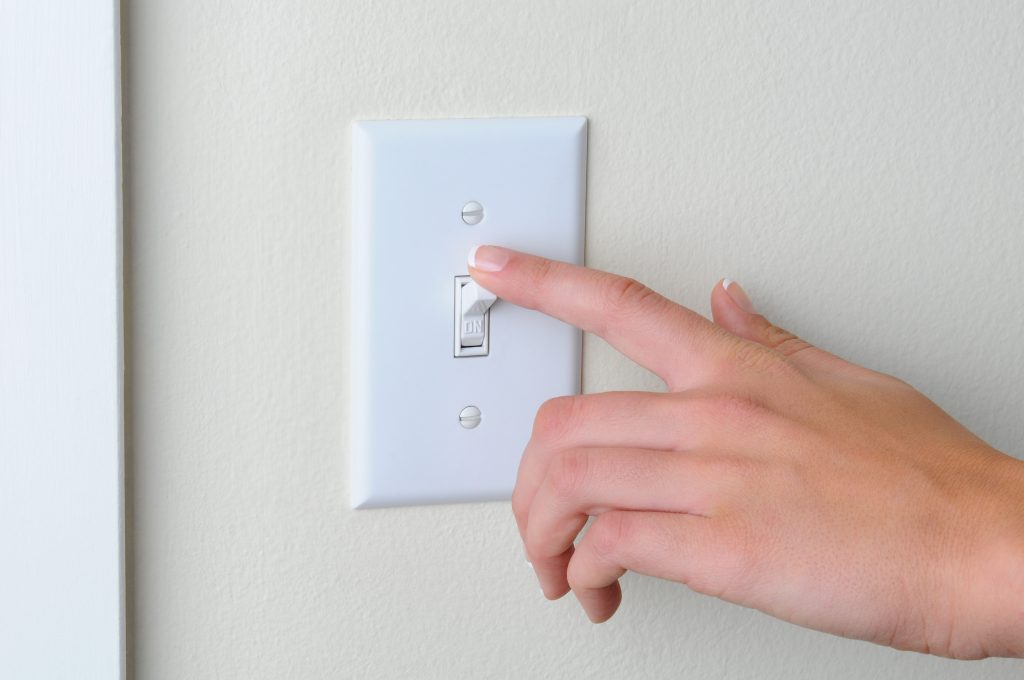This lesson demonstrates how electric circuits can be controlled with a simple switch. Students work in teams to build a working circuit with a battery and a bulb. Then, add a switch that turns the bulb on and off.
- Learn how switches control the flow of electricity.
- Learn to draw basic wiring diagrams.
- Learn to predict outcomes and draw conclusions.
Age Levels: 8-11
Materials & Preparation
Build Materials (For each team)
Required Materials
- Different types of switches
- Insulated wire
- D size battery holder
- D size battery
- 1.5 volt light socket
- 1.5 volt bulb
- Paper clips
- Paper fasteners
- Aluminum foil
- Pliers (shared)
- Wire cutter (shared)
Testing Materials & Process
Materials
- Built circuits and switches
Process
Teams build their circuits and test to confirm the bulb lights up.
Then, Teams add a switch to their circuits and demonstrate how the switch turns the bulb on and off.
- If students have difficulty creating a switch, suggest they use a paper clip bent so it’s just barely touching a piece of foil or another paper clip when pressed
- Or a paper fastener wedged in between a battery and battery holder which prevents them from making contact when pressed.
Engineering Design Challenge
Design Challenge
You are a team of engineers given the challenge of building a circuit using just a battery and a bulb. Then, you’ll need to add a switch to your circuit that will turn the bulb on and off.
Criteria
- Circuit must use a battery and a 1.5 volt bulb.
- Switch must turn bulb on and off.
Constraints
Use only the materials provided.
Activity Instructions & Procedures
- Break class into teams of 3-4.
- Hand out the Electric Switches worksheet, as well as some sheets of paper for sketching designs.
- Discuss the topics in the Background Concepts Section. Ask students for examples of how switches are used.
- Review the Engineering Design Process, Design Challenge, Criteria, Constraints and Materials.
- Provide each team with their materials.
- Explain that students must build a working circuit with just a battery and a bulb. Then, they must add a switch that turns the bulb on and off.
- Announce the amount of time they have to build (1 hour recommended).
- Use a timer or an on-line stopwatch (count down feature) to ensure you keep on time. (www.online-stopwatch.com/full-screen-stopwatch). Give students regular “time checks” so they stay on task. If they are struggling, ask questions that will lead them to a solution quicker.
- Students meet and develop a plan for their circuit and switch. They should sketch their plan before building it and use the schematic symbols shown in the “Background Concepts” Section.
- Teams build their circuits and test to confirm the bulb lights up.
- Teams add a switch to their circuits and demonstrate how the switch turns the bulb on and off.
- If students have difficulty creating a switch, suggest they use a paper clip bent so it’s just barely touching a piece of foil or another paper clip when pressed
- Or a paper fastener wedged in between a battery and battery holder which prevents them from making contact when pressed.
- As a class, discuss the student reflection questions.
- For more content on the topic, see the “Digging Deeper” section.
Extension Idea
Have students look for switches in discarded toys, appliances, or other electrical devices. Students can disassemble the items to see how they work.
Student Reflection (engineering notebook)
- Describe what you did to make the bulb light up using the switch.
- What materials did you use to make your own switch?
Time Modification
The lesson can be done in as little as 1 class period for older students. However, to help students from feeling rushed and to ensure student success (especially for younger students), split the lesson into two periods giving students more time to brainstorm, test ideas and finalize their design. Conduct the testing and debrief in the next class period.
Engineering Design Process
Background Concepts
What is a Simple Circuit?
A simple circuit consists of three minimum elements that are required to complete a functioning electric circuit: a source of electricity (battery), a path or conductor on which electricity flows (wire) and an electrical resistor (lamp) which is any device that requires electricity to operate. The illustration below shows a simple circuit containing, one battery, two wires, a switch, and a bulb. The flow of electricity is from the high potential (+) terminal of the battery through the bulb (lighting it up), and back to the negative (-) terminal, in a continual flow when the switch is in the on position so current can flow
Schematic Diagram of a Simple Circuit
The following is a schematic diagram of the simple circuit showing the electronic symbols for the battery, switch, and bulb.

IEEE/tryengineering.org
Simulating a Switch by Disconnecting a Wire
You can make a crude switch just by disconnecting one of the wires and alternately touching it and removing it from the metal case of the bulb. Why does the light go off when the wire is no longer touching? When the wire is removed, the electrons would have to flow through the air in order to complete the circuit. To make electrons flow through air requires a lot more energy than is available, because nearly all the electrons in the air are tightly bound to atoms. The same is true of all the other materials known as insulators. The makeshift switch that is made by disconnecting and reconnecting the wire does exactly the same thing as a manufactured switch, except that manufactured ones are more reliable. All they do is disconnect and reconnect the wires when you move the lever, push the button, turn the knob, or slide the button.
Vocabulary
- Battery: A device that can store electricity.
- Circuit: A complete path around which electricity can flow.
- Constraints: Limitations with material, time, size of team, etc.
- Criteria: Conditions that the design must satisfy like its overall size, etc.
- Engineers: Inventors and problem-solvers of the world. Twenty-five major specialties are recognized in engineering (see infographic).
- Engineering Design Process: Process engineers use to solve problems.
- Engineering Habits of Mind (EHM): Six unique ways that engineers think.
- Iteration: Test & redesign is one iteration. Repeat (multiple iterations).
- Prototype: A working model of the solution to be tested.
- Schematic Wiring Diagram: Diagram used to plan the wiring of a circuit.
- Simple circuit: Consists of three minimum elements that are required to complete a functioning electric circuit: a source of electricity (battery), a path or conductor on which electricity flows (wire) and an electrical resistor (lamp) which is any device that requires electricity to operate.
- Switch: A device for making, breaking, or changing the connections in an electrical circuit.
Dig Deeper
Recommended Reading
- DK Eyewitness Series: Electricity (ISBN: 0751361321)
- Eyewitness Electricity, by Steve Parker (DK Publishing, ISBN: 0789455773)
- How Science Works, by Judith Hann (Readers Digest, ISBN: 0762102497)
Writing Activity
Write an essay, or a paragraph, describing how switches found on common appliances in the home make those appliances more functional, or easier to operate.
Curriculum Alignment
Alignment to Curriculum Frameworks
Note: Lesson plans in this series are aligned to one or more of the following sets of standards:
- U.S. Science Education Standards (http://www.nap.edu/catalog.php?record_id=4962)
- U.S. Next Generation Science Standards (http://www.nextgenscience.org/)
- International Technology Education Association’s Standards for Technological Literacy (http://www.iteea.org/TAA/PDFs/xstnd.pdf)
- U.S. National Council of Teachers of Mathematics’ Principles and Standards for School Mathematics (http://www.nctm.org/standards/content.aspx?id=16909)
- U.S. Common Core State Standards for Mathematics (http://www.corestandards.org/Math)
- Computer Science Teachers Association K-12 Computer Science Standards (http://csta.acm.org/Curriculum/sub/K12Standards.html)
National Science Education Standards Grades K-4 (ages 4 – 9)
CONTENT STANDARD A: Science as Inquiry
As a result of activities, all students should develop
- Abilities necessary to do scientific inquiry
- Understanding about scientific inquiry
CONTENT STANDARD B: Physical Science
As a result of the activities, all students should develop an understanding of
- Light, heat, electricity, and magnetism
CONTENT STANDARD E: Science and Technology
As a result of activities, all students should develop
- Understanding about science and technology
National Science Education Standards Grades 5-8 (ages 10 – 14)
CONTENT STANDARD A: Science as Inquiry
As a result of activities, all students should develop
- Abilities necessary to do scientific inquiry
- Understandings about scientific inquiry
CONTENT STANDARD B: Physical Science
As a result of their activities, all students should develop an understanding of
- Transfer of energy
CONTENT STANDARD E: Science and Technology
As a result of activities, all students should develop
- Understandings about science and technology
Next Generation Science Standards – Grades 3-5 (Ages 8-11)
Students who demonstrate understanding can:
- 4-PS3-4. Apply scientific ideas to design, test, and refine a device that converts energy from one form to another.
Engineering Design
Students who demonstrate understanding can:
- 3-5-ETS1-1.Define a simple design problem reflecting a need or a want that includes specified criteria for success and constraints on materials, time, or cost.
- 3-5-ETS1-2.Generate and compare multiple possible solutions to a problem based on how well each is likely to meet the criteria and constraints of the problem.
Next Generation Science Standards – Grades 6-8 (Ages 11-14)
Engineering Design
Students who demonstrate understanding can:
- MS-ETS1-1 Define the criteria and constraints of a design problem with sufficient precision to ensure a successful solution, taking into account relevant scientific principles and potential impacts on people and the natural environment that may limit possible solutions.
- MS-ETS1-2 Evaluate competing design solutions using a systematic process to determine how well they meet the criteria and constraints of the problem.
Standards for Technological Literacy – All Ages
Design
- Standard 8: Students will develop an understanding of the attributes of design.
- Standard 9: Students will develop an understanding of engineering design.
- Standard 10: Students will develop an understanding of the role of troubleshooting, research and development, invention and innovation, and experimentation in problem solving.
Related Engineering Fields and Degrees
Student Worksheet
Challenge
Describe the function of switches on the following household appliances. Is there more than one switch on any of these items?Portable Vacuum Toaster Hair Dryer Coffee Maker
Electric Fan
Desk Lamp

SCPhotog-bigstock.com
You are the Engineer!
Instructions:
- You need to design a system that will turn a light on and off in the hallway of a new office building.
- Build a working circuit with just a battery and a bulb.
- Next, add a switch in such a way that the switch turns the bulb on and off.
- Draw and describe your circuits and switches in the space below using the schematic symbols shown on the Student Resource Sheet.
- Discuss your designs and experiences with the class.
Circuit Without Switch Circuit With Switch Describe what you did to make the bulb light up using the switch:
What materials did you use to make your own switch?
Translations





 Industrial Engineering
Industrial Engineering
 Computer Engineering
Computer Engineering